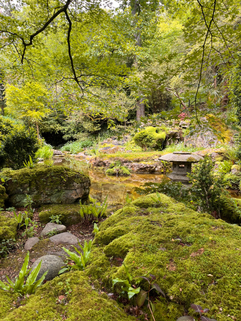Iford Manor - Enchanting Havens
- Lilium

- May 24, 2023
- 3 min read

Iford Manor is home to Grade I Listed Gardens, located on the last hill of the Cotswolds, with the Wiltshire/Somerset border running through the garden itself, the gardens are a glorious, romantic idyll.
With a companion in tow, I arrived at Iford a few days after the coronation, a reminder of the event was a union jack flying in the wind at the front of the house above an immense amount of wisteria. I have a deep love of wisteria, and little did I know, the creators of the Iford Manor gardens felt the same way. Walking down the path in front of the house wisteria was growing on both sides, trained around the windows of the house, and grown as trees along the other side of the path. The fragrance was heavenly and the purple flowers shone out against the warm Bath stone of the house. Through a door in a wall and we were in a small courtyard, purple tulips were blown out, dying beautifully in their final hours. Opposite a small Italianate porch was a small fountain draped with ivy. A flight of stone steps were luring us to climb but a small path to the right won us over.
Another small fountain tricked on the left, the river opposite the road could be heard rushing past. A beautiful statue of a man was laying across a doorframe on the other side of the road, perfectly framed by the wisteria.
The path opened up into a striped lawn, on the left a garden house could be seen but the end of the path led to a tiny corner of Italy, the Cloisters.
The Cloisters were what first led me to visit Iford House, it hardly looked like it could be a small corner of England. Yet here it was, a medical style cloister with stretching views over the Wiltshire valley below. We had this enchanting place all to ourselves, the only soundtrack was made by various small acers that whispered in the breeze, the birds and the river, the silence reminded me of a line in Brideshead Revisited: "It was this cloistral hush which gave our laughter its resonance."
We made our way across the lawn to the garden house, up the steps and onto the Great Terrace. More wisteria twisted its way around the pillars and two dogs guarded a flight of steps that led to what would be one of my favourite parts of the gardens.
The Lily Pool had been walled in with wisteria, its flowers brushing over the surface of the water while koi fish swam lazily below. I had never seen wisteria planted around water before, it was magical. I added the idea for my own future garden in Wiltshire, imaging a statue of Antinous peering into the water at the refection of the purple flowers.
We returned up the steps to be greeted by the most wonderful sight, wild garlic had been planted over a flight of stone steps that led up to a King Edward VII column, all the white flowers tumbling down made it look like a stairway to heaven. Amongst the garlic and ivy in the woods was a statue of Papageno, a character from Mozart's opera The Magic Flute.
A path on the left of the stairs led to a Japanese garden, all swathed in moss, the sound of a small waterfall harmonised with the spring bird song.
Returning once more to the Great Terrace we walked along admiring the tulips and the first buds of the peonies.
At the end of the terrace was the Casita (translating to “small house” in Spanish) which overlooked a topiary garden. The entrance was framed by the most beautiful wisteria yet, scattering its petals across the floor and into the small bubbling fountain below it.
Stepping back once more onto the terrace, a door in the wall opened out into an orchard, the last of the blossom was still holding onto the trees and the white wild flowers moved with the long grass in the breeze, it all looked like something out of painting.
We stepped once more onto the lawn by the lily pool to admire a spring display, we followed the path behind it and heading down another flight of stairs to the Patio Garden.
The Patio Garden was framed once again with wisteria, blue flowered rosemary tumbled over the walls and roses, not yet in flower, were trained along the length of the lawn.
We found ourselves at the top of the stairs that had first beckoned us on our arrival in the garden, heading down them and we were on the Conservatory Terrace, the pillars of the stairs marked by large black urns. I was more than disappointed that we had reached the end but I had learnt a most invaluable lesson: one can never have too much wisteria.


























































































































































































Comments